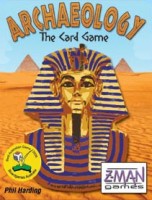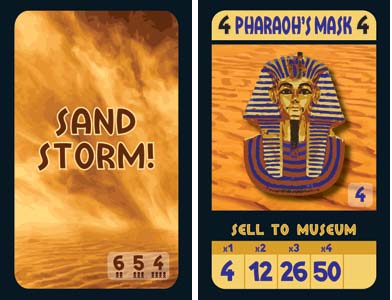
Archaeology – The Card Game
2-4
8+
20+
Discover the lost treasures of Egypt and make your fortune!
You are an archaeologist working the dig sites of the Egyptian desert. Search for the right pieces to complete torn parchments, broken pots, and other priceless artifacts. Trade shrewdly at the marketplace to increase the value of your collection. Sell your treasures to the museum for maximum profit.
But beware, the desert also has its dangers! A devastating sandstorm can throw your expedition into disarray, and cunning thieves lurk around the dig site ready to steal your prize discovery.

images © Z-Man Games
User Reviews (3)
Add a Review for "Archaeology – The Card Game"
You must be logged in to add a review.

As the case is with many card games, this is a simple and quick to learn to play game, actually among the easiest. Even so, there is a significant amount of strategy to it, which makes it particularly interesting and challenging! Moreover, there is a considerably degree of luck present.
Cards are the game’s only component. They are divided into 2 main categories: The treasure cards and the special events cards. The treasure cards include several different types of treasures with different values for each one. The special events cards are thieves and sandstorms. They add a nice variety to the game and the element of surprise. Sandstorms in particular, affect all the players and are posing a strong issue of risk management; that is, the more cards a players has in hand the more he/she will be affected by the sandstorm (there is no limit on how many cards a player can have in hand).
The turn sequence follows a partially structured order, one player following another after completing his/her turn. There is no interaction among the players, except on the occasion of the thief card. During a turn, a player draws a single card and then can perform several actions in any order and as often as wanted. These actions can be: selling treasure cards to the museum, exchanging treasure cards with the marketplace, or exploring one of the three pyramid chambers for treasure cards (under conditions).
The winner of the game is the player with treasures which have the highest combined value after there are no more cards to draw and all players have finished their last turns. All cards sold to the museum will score points.
The primary strategic element in this game is the creation of sets of cards of the same type of treasure. Each treasure (card) has a value that increases when there are several of the same cards at a set. Usually selling a single card to the museum will not wield much value and there are occasions that only the complete treasure set will have a significant value. Therefore, players will want to collect treasure cards of the same type before selling to the museum. That is usually achieved by making exchanges with the marketplace which is a collection of face-up cards accessible to all players. The exchange value of a card is not the same as its sale value by the way. When exchanging cards with the marketplace, one can offer as many cards desired and receive cards with a combined exchange value equal or less to the value of the ones offered.
As far as the game’s design is concerned, it’s okay to my opinion. Not really beautiful, but pretty nice and befitting the theme of the game quite well.
Overall, Archaeology – The card game is a nice and clever card game. I do recommend it for anyone looking for a quick and light game and a reasonable amount of challenge and strategy.
Game duration is around 20′ and the allowed numbers of players from 2 to 4.
Archaeology-The Card Game by Phil Harding and published by Z Man Games is a light, quick game for two to four players. It works well with all player counts, is easy to learn, and is a bargain at $10-$12. Setup is easy, and the game plays in about 20 minutes. Kids as young as eight or so should be able to grasp the concepts of Archaeology in no time.
The game is exceptionally portable with its roughly 5″x 4″x 3/4” box. The components consist of 87 cards and a rule booklet. Setup begins by separating Artifact cards from the Map, Sandstorm, and Thief cards. Then five Artifact cards are placed face up to create the “market” and stacks of three, five, and seven Artifact cards are placed around a reference card in a thematic “pyramid” shape. Next each player receives four cards as a starting hand. Finally, the Map, Sandstorm, and Thief cards are shuffled into the remaining Artifact cards. The resulting deck becomes the “dig site”, and the game is ready to play.
Play begins with the first player taking one card from the dig site and placing it into his hand. He may chose to trade any number of cards in his hand with those in the market. Cards are traded at a 1:1 value ratio, and the trade value is clearly marked on each card. A player may also choose to take a set of matched cards and “sell (them) to the museum”. This means the player places the cards to be sold in front of him. But, a player cannot add cards to or take cards from a set that has been sold. They are now his to score at game’s end, and they cannot be lost or stolen. The values of a given set of matched cards increases exponentially as the number of cards in the set increases. But there are events which can cause a player to lose one or more of the cards in his hand.
The Sandstorm cards cause each player to drop half the cards (rounded down) from their hand. And the Thief card allows the player who drew it to take one card from one of his opponents. The presence of Sandstorm and Thief cards make it risky to try and collect a large set of cards. The press your luck nature these cards create adds tension and excitement to the game. Even with the Thief cards, the game is not confrontational in nature. The player who draws the Thief has to blindly pick from his opponent’s hand, so he cannot target a specific highly valued card.
The third and last non Artifact card is the Map. When a player draws a Map card, he may keep it, trade it in the market, or use it to take one of the three stacks of cards that comprise the pyramid. With one, two, or three Map cards, a player may claim the three, five, or seven card stacks. Map cards are rare, but using them to grab a few extra cards can be a game changer.
Play continues until the dig site deck is exhausted. Then players make their final trades, and sell their cards to the museum. The player with the greatest number of points is the winner. Archaeology-The Card Game is a relaxing filler in a compact package. It would make a fine family game, yet it plays well with two. It shares some elements of Jaipur and Rummy, but it is distinctive enough to consider adding to one’s collection.
Introduction
This card game has nothing to do with Indiana Jones, except for the fact that you play as an archaeologist in Egypt. However, I keep on imagining myself as Indy when I play this. (Cue Indiana Jones Theme Music)
What a surprisingly fun card game! It reminds me of the old card game Rummy, where players try to make certain combinations in order to score points.
Gameplay:
The game is simple, you are trying to gather sets of ancient artifacts and then sell them to the museum for points. The more of one type of artifact you have, the more points you get. The person with the most points wins at the end.
Players start their turn by “digging up” an artifact from the desert (drawing a card). If it is a thief card they may use it to steal a card from an opponent. A Sandstorm card causes everyone to lose half of their cards in hand. Otherwise it is a map or treasure card that goes into their hand.
Next, players can exchange cards in hand for those at the marketplace at a value equal or less than the amount at the top of the card. You can exchange multiple cards for one card, or one card for multiple cards. If the player has a map card (or a certain number of them), they can explore the pyramid for treasure, which can be great or a bust.
Finally, they can sell their items to a museum for points. The more of one type of item you have, the more points you get, so you generally don’t want to just sell individual cards. After that, it’s the next player’s turn. The player with the most points at the end of the game, wins!
Pros:
-Quick set up and learning time.
-Portable.
-Not much reading or math involved.
-Fast!
-Good for families.
-Some light strategy/planning but very much reliant on luck.
-If you enjoyed the card game Rummy, then I think you will enjoy this.
-Nice theme and simple rule book.
Cons:
-Basically an improved Rummy.
-Maybe too reliant on luck with card drawing, map cards, and random sandstorms.
-Not a lot of strategy/planning.
-Certain cards are much better to go after, if you can.
Overall
This is a fun, light, portable game that you can play a game or two of with almost anyone. Games take 20-30 mins after the first play through. While there is some stealing from others involved, the game is so light and there is very little interaction between players that this isn’t a “gotcha!” game and feelings aren’t really hurt. Additionally, with very few words and just a little math for scoring, this is a good family game. I’ve only played it with 4 players, but it seems like it would scale down nicely. All in all, for the low price, I would definitely recommend picking this up. However, this isn’t a game you are going to bring out and play constantly. I suggest packing it for visiting family or trips, and playing it between games.